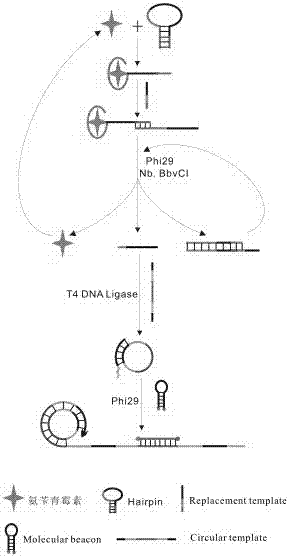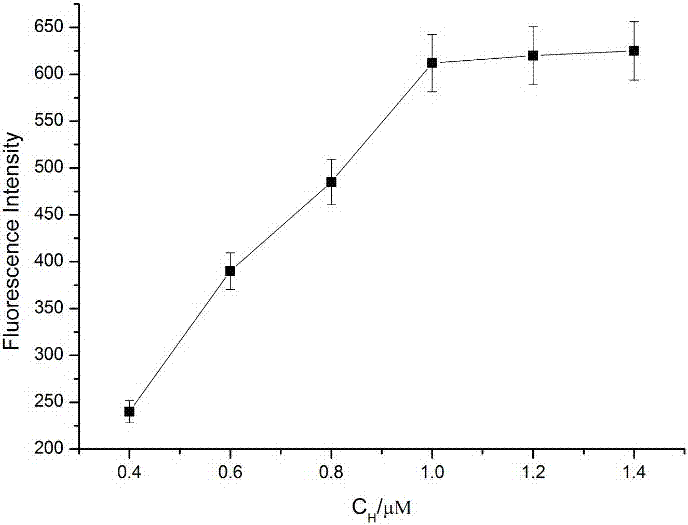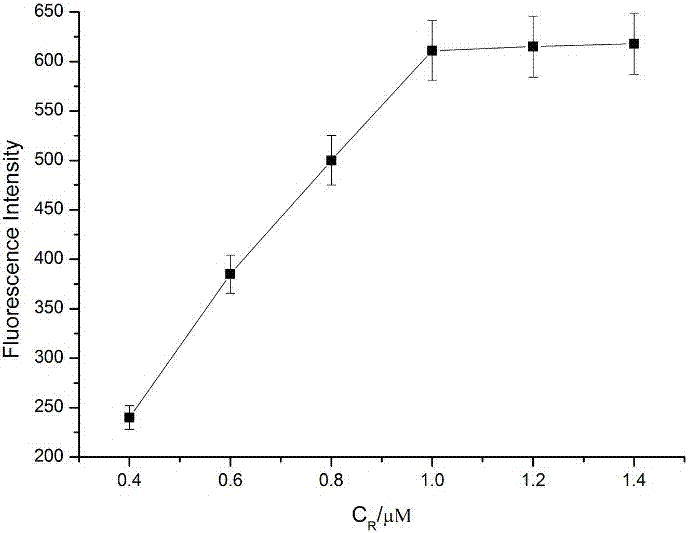Method for detecting ampicillin based on aptamer
An ampicillin, nucleic acid aptamer technology, applied in biochemical equipment and methods, microbial determination/inspection, etc., can solve the problems of complex analysis process, low specificity and sensitivity, long time-consuming analysis and detection, etc. Fluorescence signal, improved sensitivity, low detection cost
- Summary
- Abstract
- Description
- Claims
- Application Information
AI Technical Summary
Problems solved by technology
Method used
Image
Examples
Embodiment 1
[0036] a. Mix 1 μL of different concentrations of Hairpin (final concentrations are 0.4 μM, 0.6 μM, 0.8 μM, 1.0 μM, 1.2 μM, 1.4 μM), Replacement template (1 μL, 10 μM), phi29 DNA polymerase (1 μL, 10×) , dNTPs (1 μL), Nb.BbvCI (1μL, 10×), NEB buffer (5μL, 10×) and the substance to be tested (ampicillin) were added to the EP tube, shaken for 30s, and placed in a water bath at 37°C for 30 minutes;
[0037] b. Take the reacted solution out of the water bath, put it into a water bath at 85°C and heat it for 10 minutes to inactivate the enzyme in the system, then add Circular template (1 μL, 10×), T4 DNA into the EP tube Ligase (1 μL, 10×), incubated at 16°C for 12 h;
[0038] c. After heat preservation treatment at 16°C, put it in a water bath at 65°C for 15 minutes, then add Molecularbeacon (1 μL, 10×) and phi29 DNA polymerase (1 μL, 10×) into the EP tube, and place in a water bath at 37°C Water bath for 30min. Take out the mixed solution from the water bath, and measure the ...
Embodiment 2
[0041] a. Mix 1 μL of different concentrations of Replacement template (final concentrations are 0.4 μM, 0.6 μM, 0.8 μM, 1.0 μM, 1.2 μM, 1.4 μM), Hairpin (1 μL, 10 μM), phi29 DNA polymerase (1 μL, 10×) , dNTPs (1 μL), Nb.BbvCI (1μL, 10×), NEB buffer (5μL, 10×) and the substance to be tested (ampicillin) were added to the EP tube, shaken for 30s, and placed in a water bath at 37°C for 30 minutes;
[0042] b. Take the reacted solution out of the water bath, put it into a water bath at 85°C and heat it for 10 minutes to inactivate the enzyme in the system, then add Circular template (1 μL, 10×), T4 DNA into the EP tube Ligase (1 μL, 10×), incubated at 16°C for 12 h;
[0043] c. After heat preservation treatment at 16°C, put it in a water bath at 65°C for 15 minutes, then add Molecularbeacon (1 μL, 10×) and phi29 DNA polymerase (1 μL, 10×) into the EP tube, and place in a water bath at 37°C Water bath for 30min. Take out the mixed solution from the water bath, and measure the ...
Embodiment 3
[0046] a. Add Hairpin (1μL, 10μM), Replacement template (1μL, 10μM), phi29 DNA polymerase (1μL, 10×), dNTP (1μL), Nb.BbvCI (1μL, 10×), NEB buffer (5μL, 10×) and the substance to be tested (ampicillin) were added to the EP tube, shaken for 30s, and placed in a water bath at 37°C for 30 minutes;
[0047] b. Take the reacted solution out of the water bath, put it into a water bath at 85°C and heat it for 10 minutes to inactivate the enzyme in the system, and then add 1 μL of Circular template of different concentrations to the EP tube (the final concentrations are respectively 0.4μM, 0.6μM, 0.8μM, 1.0μM, 1.2μM, 1.4μM), T4 DNA ligase (1μL, 10×), incubate at 16°C for 12 h;
[0048] c. After heat preservation treatment at 16°C, put it in a water bath at 65°C for 15 minutes, then add Molecularbeacon (1 μL, 10×) and phi29 DNA polymerase (1 μL, 10×) into the EP tube, and place in a water bath at 37°C Water bath for 30min. Take out the mixed solution from the water bath, and measure ...
PUM
 Login to View More
Login to View More Abstract
Description
Claims
Application Information
 Login to View More
Login to View More - R&D
- Intellectual Property
- Life Sciences
- Materials
- Tech Scout
- Unparalleled Data Quality
- Higher Quality Content
- 60% Fewer Hallucinations
Browse by: Latest US Patents, China's latest patents, Technical Efficacy Thesaurus, Application Domain, Technology Topic, Popular Technical Reports.
© 2025 PatSnap. All rights reserved.Legal|Privacy policy|Modern Slavery Act Transparency Statement|Sitemap|About US| Contact US: help@patsnap.com



